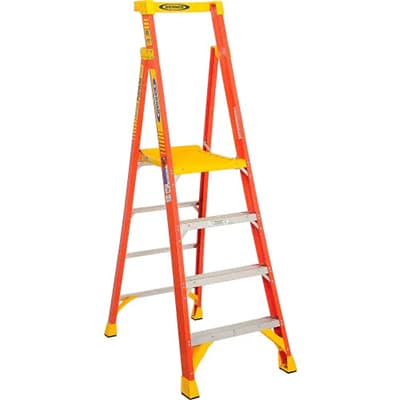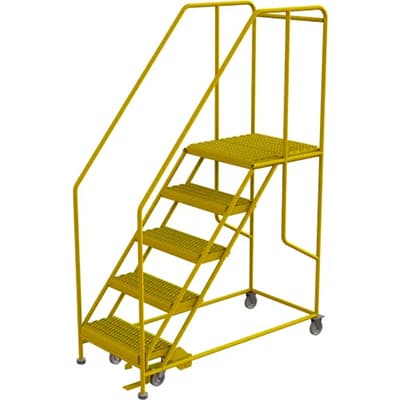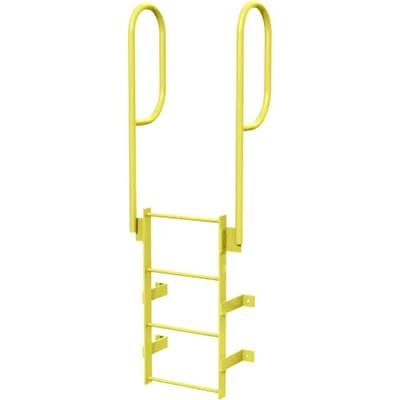Climb New Heights With the Latest Ladder Buying Guide
The humble ladder may initially seem simple, with many picturing a basic metal frame with rungs for climbing. However, all ladders are actually deceptively complex pieces of equipment, with some being highly complex and engineered for specific tasks, applications, and industries.
Now there are many different kinds of ladders now available across a wide range of industries. And while they come in a vast array of shapes and sizes, each designed to fulfill specific safety requirements and job functions, we can split them into three main types:
DIFFERENT TYPES OF LADDERS
Portable Ladders
Think of portable ladders as the most traditional. They’re the kind that are loaded onto the top of a van or truck, are lightweight, can extend various lengths, and usually consist of side rails joined at equidistant intervals by rungs or steps. These models are suitable for small to medium-sized tasks and are the workhorses of the industry. Because they’re so ubiquitous, and therefore operated by so many different people, OSHA has a lot of safety guidelines for them. These guides include:
- Slip-resistant rungs, steps and/or cleats.
- Metal spreader or locking device that securely locks the ladder in an open position.
- Maximum loads for each portable ladder type.
- Securing ladders and using temporary barricades when used in passageways, doorways, and driveways.
- Securing and stabilizing ladders on slippery surfaces.
- NO moving of ladders while they’re in use.
- NO usage of top steps and stepladder caps.
- NO fastening together ladders to provide additional length (unless it’s part of the design).
Mobile Ladders
It may be easy to confuse portable ladders with mobile ladder applications, but there are big differences. Usually, a mobile ladder is a movable, fixed-height, self-supporting ladder that comes with wheels or castors on a rigid base, with steps leading to a top step. It will usually come with safety features like handrails, is designed for one employee at a time, and is a great deal heavier than a portable ladder. Again, OSHA supplies safety guidelines for mobile ladders which include:
- A minimum 16-inch step width.
- Slip-resistant steps and platforms.
- Must support at least four times the maximum intended load.
- Wheels/casters must support their proportional share of four times the maximum intended load, PLUS their proportional share of the unit’s weight.
- Any ladder with a top step height of 4 feet or higher must have handrails with a vertical height of 29.5 to 37 inches (measured from front edge of a step or rung).
- Removable gates or chains may be used instead of handrails in special-use applications.
- Maximum work-surface height must not exceed four times the shortest base dimension without additional support.
- Stabilizing outriggers, counterweights, or comparable means to prevent overturning must be used for greater heights.
- Must have wheels or casters equipped with a system to impede horizontal movement when an employee is on it.
Fixed Ladders
Finally, we come to fixed ladders, which are generally considered the safest kind and are ideal for repeated, frequent usage or long-term projects. Fixed ladders are used in various industries to provide slip resistance, prevent corrosion, and even facilitate sanitation. Common applications that require fixed ladders include industrial facilities, wind turbines, telecommunications, crane installation, and drilling rigs/platforms.
Of course, the one drawback is that they are not easily movable (or removable) - but again, that is by design. Ladders intended for long-term use on projects that benefit from ladders and platforms that will be there for weeks, months, years, or indeed a permanent fixture. And while considered a very safe method of climbing, OSHA does of course have guidelines in place for fixed ladders which includes:
- Fixed wooden ladders may not be coated with any material that could obscure structural defects.
- There should be nothing on the rungs that could cause a slipping hazard.
- Fixed ladders should be inspected to ensure there are no puncture or laceration hazards (like protruding screws or nails).
- Fixed ladders that exceed 24 feet must be equipped with a personal fall arrest system, ladder safety system, cage or well.
- Maintain three points of contact when climbing a fixed ladder. Two hands/one foot or two feet/one hand.
- Never over-extend yourself to either side of the fixed ladder; this can cause you to lose balance.
- Never carry any load when climbing a fixed ladder that could cause you to lose balance.
- Always face the fixed ladder when climbing up or down.
- Keep the area around the top and bottom of the ladder clear.
- Do not use a fixed ladder that has a pitch greater than 90 degrees from the horizontal.
From those three main types of ladders, some models are designed for specific tasks or applications. Let’s take a look at the most common ones:
Rolling Ladders
Rolling ladders provide easy mobility for tasks that require movement. They feature wheels for easy transportation and a locking mechanism for stability during use. With safety handrails and wide steps, they’re a fitting choice for warehouse or retail environments.
Step Stools
Step stools, although small, are effective in enhancing efficiency. These compact tools are easy to move and store, perfect for tasks requiring a slight height increase, like reaching high shelves or equipment. Despite their size, they provide a sturdy and secure platform, making tiptoeing unnecessary. And under the step stool umbrella are a host of different kinds including stationary, mobile, adjustable height, and even child-friendly models.
Personnel Lifts
Personnel lifts elevate the concept of ladders. These machines lift workers and their tools to heights beyond the reach of traditional ladders. The standout feature of these lifts is their electrically-controlled platform. A simple button press adjusts the platform's height, enabling workers to reach their workspace without strain or risk. The lift's design also accommodates weight distribution and load-carrying capacity, transporting heavy equipment up and down safely and efficiently. Again, you have multiple options here, including power stock pickers, scissor lifts, forklift platforms, and high-platform maintenance lifts.
Configurable Ladders and Platforms
For versatility and adaptability, configurable ladders and platforms stand out. The adjustable structure of these ladders allows you to mold them into different shapes and sizes based on your needs. For instance, you can transform them into a low-rise platform for slightly elevated work or extend them into a long, straight ladder for high shelves. This adaptability enhances convenience and safety by ensuring stability and reducing accident risks.
Crossover Ladders
Also known as a crossover platform, a crossover ladder is a raised surface that allows a person to safely walk over gaps, obstacles or hazardous areas rather than go around, climb over or walk through them. In industrial settings, they give workers a safe path over conveyors, machines, pipes and other objects.
Hybrid Foldaway Ladders
These new “hybrid” steel and aluminum construction ladders have the strength you need for safe climbing, but are lightweight for easy maneuverability. And they are available in a wide range of sizes, from 6-step all the way to 12-step, with an impressive 450lb weight capacity.
Mounted Ladders
Regular wall mounted ladders are commonly used for access to roofs, mezzanines, and other elevated areas. There are two kinds – steel ladders which are durable for handling most work environments with serrated steps for maximum slip resistance; and fiberglass ladders that are corrosion resistant, non-conductive, and lightweight, with grit-coated steps to provide good slip resistance.
Safety Cage Ladders
When you need additional protection a safety cage ladder is just what the doctor ordered. In an effort to prevent falls from these fixed ladders, cages or basket guards enclose the ladder’s climbing space and are attached to the building or the ladder itself. These cages can help workers regain their balance or reaffirm their foothold instead of falling backward in the case of a slip.
Scaffolding Bases, Stages and Components
Scaffolding is a crucial element in the construction industry, providing workers a secure and elevated working platform. Although there are many varieties of scaffolding systems, a common one is called independent tube and coupling scaffolding – popular because it transports efficiently, erects intuitively, and breaks down easily. Other scaffolding designs are used inside facilities for worker access to overhead equipment, for painting, etc. These designs are usually limited in height but have other features such as the ability to fold or telescope. Still, other scaffolds are available for specialized tasks such as building aircraft. Scaffolding must adhere to OSHA standards for performance requirements and structural design methods. Because scaffolding must be compatible with a wide array of buildings and structures, there are numerous kinds of scaffolds to meet specific building requirements.
Stair Landings
The stair landing’s modularity and adjustability allow the flexibility needed to accommodate virtually any layout and a wide range of entrance heights. This durable, aluminum stair system can be used in all weather conditions and is built to take on the rigors of high-traffic, repeated use.
Step Ladders
A stepladder is a portable, self-supporting, A-frame ladder. It has two front side rails and two rear side rails. There are steps mounted between the front side rails and bracing between the rear side rails.
Straight and Extension Ladders
Also known as single ladders, straight ladders look like one half of a stepladder. As a non-self-supporting ladder, straight ladders require some form of anchor at their topmost section. Straight ladders are portable, but they do not have hinges that can decrease the amount of space they occupy when not in use.
Work Platforms
These versatile platforms raise or lower workers to optimal heights to increase productivity and reduce the risk of back injuries and fatigue. They’re used in packing and assembly stations, HVAC installations, areas where heavy machinery is operated, and other industrial applications.
Don’t Forget Complementary Ladder Products and Accessories
Buying a great ladder isn’t the end of the story. You should also invest in appropriate products, accessories and safety gear to work hand-in-hand with your ladders and lifts for the best possible experience for your employees. This includes:
Remember, while ladders and lifts are elevation enablers, there’s also that old adage – what comes up must come down – and you want to make sure you do that safely. So, make sure you check out our many safety products to keep your team safe.
And there you have it. Whatever your ladder needs are, from something basic but tried and true like a step ladder or extension ladder, to something more permanent like a fixed system with platforms, Global Industrial has just what you need to help you reach new heights safely. And remember, if you don’t see exactly what you’re looking for please reach out to our experts, we’ll be happy to put together the perfect recommendation for you.
The information contained in this article is for informational, educational, and promotional purposes only and is based on information available as of the initial date of publication. It is the reader’s responsibility to ensure compliance with all applicable laws, rules, codes and regulations. If there is any question or doubt in regard to any element contained in this article, please consult a licensed professional. Under no circumstances will Global Industrial be liable for any loss or damage caused by your reliance on this article.


